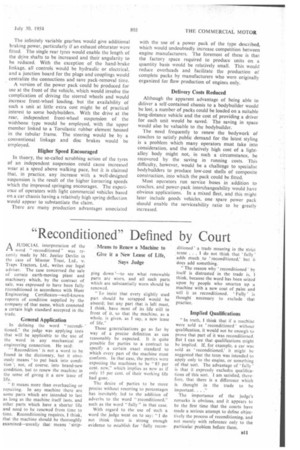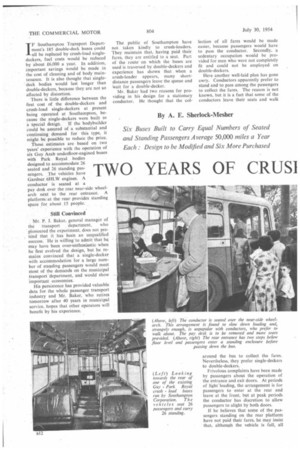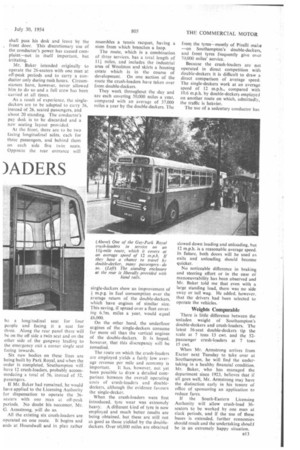"Reconditioned" Defined by Court
Page 45

Page 46

Page 47

If you've noticed an error in this article please click here to report it so we can fix it.
1-1 A JUDICIAL interpretation of theword " reconditioned was re
cently made by Mr. Justice Devlin in the case of Minster Trust, Lid., r. Traps Tractors, Ltd., writes our legal adviser. The case concerned the sale of certain earth-moving plant and machinery which, by the contract of sale, was expressed to have been fully reconditioned in accordance with Hunt Engineering Certificates—well-known reports of condition supplied by the company of that name, which connoted a certain high standard accepted in the trade.
General Application In defining the word reconditioned." the judge was applying tests that will be applicable to the use of the word in any mechanical or engineering connection. He said;
"
Recondition' is not a word to be found in the dictionary, but it obviously means • to put back into condition '; not, of course, into brand-new condition, but to renew the machine in the sense of giving it a new lease of life.
It means more than overhauling or repairing. In any machine there are some parts which are intended to last as long as the machine itself lasts, and other parts which have a shorter life and need to be renewed from time to time. Reconditioning requires. I think, that the machine should be thoroughly examined—usually that means strip ping down '—to see what renewable parts are worn, and all such parts which are substantially worn should be renewed. . Means to Renew a Machine to Give it a New Lease of Life, Says Judge
"To insist that every slightly used part should be scrapped would be absurd; but any part that is left must, I think, have most of its life still in front of it, so that the machine, as a whole. is given, as I say, a new lease of life."
Those generalizations go as far by way of a precise definition as can reasonably be expected. It is quite possible for parties to a contract to specify a certain exact standard to which every part of the machine must conform. In that case, the parties were expecting the machines to be "85 per cent. new," which implies as new as if only 15 per cent, of their working life had gone.
The desire of parties to be more precise without resorting to percentages has inevitably led to the addition of adverbs to the word "reconditioned." such as the word "fully" in that case.
With regard to the use of such a word the judge went on to say: "I do not think there is strong enough evidence to establish for 'fully recon
ditioned ' a trade meaning in the strict sense . . I do not think that 'fully' adds much to ' reconditioned,' but it does add something.
"The reason why 'reconditioned ' by itself is distrusted in the trade is, I think, because the word has been seized upon by people who smarten up a machine with a new coat of paint and
sell it as reconditioned. Fully ' is thought necessary to exclude that practice.
Implied Qualifications "In truth, I think that if a machine were sold as 'reconditioned' without qualification, it would not be enough to prove that part of it was reconditioned. But I can see that qualifications might he implied. If, for example, a car was sold as 'reconditioned,' it might be suggested that the term was intended to apply only to the engine, or something of that sort. The advantage of 'fully ' is that it expressly excludes qualifications of this sort. I am satisfied, therefore, that there is a difference which is thought in the trade to be important. . . ."
The importance of the judge's remarks is obvious, and it appears to be the first time that the courts have made a serious attempt to define objectively the process of reconditioning, and not merely with reference only to the particular problem before them.
/ F Southampton Transport Depart ment's 185 double-deck buses could all be replaced by crush-load singledeckers, fuel costs would be reduced by about £6,000 a year. In addition, important savings would be made in the cost of cleaning and of body maintenance. It is also thought that singledeck bodies would last longer than double-deckers, because they are not so affected by distortion.
There is little difference between the first cost of the double-deckers and crush-load single-deckers at present being operated at Southampton, because the single-deckers were built to a special design. If the bodybuilder could be assured of a substantial and continuing demand for this type, it might be possible to reduce the price.
These estimates are based on two years' experience with the operation of six Guy Arab underflocrr-engined buses with Park Royal bodies designed to accommodate 26 seated and 26 standing passengers. The vehicles have Gardner 6HLW engines. A conductor is seated at a pay desk over the rear near-side wheelarch next to the rear entrance. A platform at the rear provides standing space for about 15 people.
Still Convinced
Mr. P. J. Baker, general manager of the transport department, who pioneered the experiment, does not pretend that it has been an unqualified succcss. He is willing to admit that he may have been over-enthusiastic when he first evolved the design, but he remains convinced that a single-decker with accommodation for a large number of standing passengers would meet Most of the demands on the municipal transport department, and would show important economies.
His persistence has provided valuable data for the whole passenger transport industry and Mr. Baker, who retires tomorrow after 40 years in municipal service, hopes that other operators will benefit by his experience.
The public of Southampton have not taken kindly to crush-loaders. They maintain that, having paid their fares, they are entitled to a seat. Part of the routeon which the buses are used is traversed by double-deckers and experience has shown that when a crush-loader appears, many shortdistance passengers leave the queue and i,vait for a double-decker.
Mr. Baker had two reasons for providing in his design for a stationary conductor. He thought that the col
lection of all fares would be made easier, because passengers would have to pass the conductor. Secondly, a sedentary occupation would be provided for men who were not completely fit and could not be employed on double-deckers.
Here another well-laid plan has gone awry. Conductors apparently prefer to stand and to pass among the passengers to collect the fares. The reason is not known, but it is a fact that some of the conductors leave their seats and walk shall pass his desk and leave by the front door. This discretionary use of the conductor's power has caused complaint—not in itself important, but irritating.
Mr. Baker intended originally to operate the 26-seaters with one man at off-peak periods and to carry a conductor only during rush hours. Circumstances have, however, never allowed him to do so and a full crew has been carried at all times.
As a result of experience. the singledeckers arc to be adapted to carry 36, instead of 26, seated passengers, and about 20 standing. The conductor's pay desk is to be discarded and a new seating layout provided.
At the front, there are to be two facing longitudinal seats, each for three passengers, and behind them on each side five twin seats. Opposite the rear entrance will resembles a tennis racquet, having a stem from which branches a loop.
The route, which is a combination of three services, has a total length of 111 miles, and includes the industrial area of Woolston and skirts a housing estate which is in the course of development. On one section of the route the crush-loaders have taken over from double-deckers.
They work throughout the .day and are each covering 50,000 miles a year, compared with an average of 37,000 miles a year by the double-deckers. The from the tyres—mostly of Pirelli make —on Southampton's double-deckers, and front tyres frequently give over 70,000 miles' service.
Because the crush-loaders are not operated in direct competition with double-deckers it is difficult to draw a direct comparison of average speed. The single-deckers work at an average speed of 12 m.p.h., compared with 10.6 m.p.h. by double-deckers employed on another route on which, admittedly, the traffic is heavier.
The use of a sedentary conductor has




















































































